Nausicaa of the Valley of the Wind (Japan, 1984)
July 12, 2020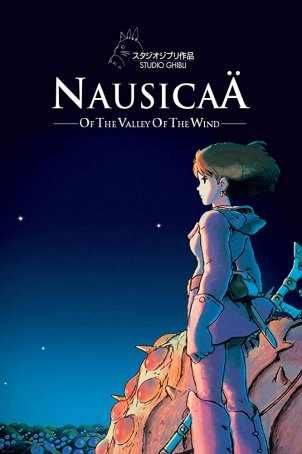
Nausicaa of the Valley of the Wind, the first
theatrical collaboration of Japanese animation icons Hayao Miyazaki (directing
his second feature film) and Isao Takahata, led directly to the formation of
Studio Ghibli, which was founded only a little more than a year after Nausicaa
reached Japanese theaters. An epic fantasy adventure, the film was based on a
manga created by Miyazaki in 1982 and features many of the elements that would
become common in the filmmaker’s future work, including environmental themes,
cyberpunk stylizations, and a strong female lead. The movie is somewhat hamstrung
by its complexity. In order to “fit” the manga into a two-hour movie, Miyazaki
was forced to condense and delete and, especially regarding the political
elements and (warring) interaction between various kingdoms, things can become
confusing. As with many of Miyazaki’s films, there’s a sense that, although
kids may enjoy the proceedings, there’s a lot more here for adults.
The film transpires one thousand years in the future
following the destruction of civilization in the Seven Days of Fire. Miyazaki,
a child of World War II (he was born in 1941) has often expressed the fears and
concerns of his generation in his films. The movie follows the exploits of the
title character, Nausicaa (Sumi Shimamoto), who is a princess of the kingdom of
the Valley of the Wind. She has an uncanny ability to communicate with the
“insects” that inhabit the Toxic Jungle. Among these are the huge Ohms, armored
creatures that look like a cross between an armadillo and a crustacean.
Although generally peaceful, the ohms, if enraged (detectable by the change of
their eye color to red), can become dangerous.
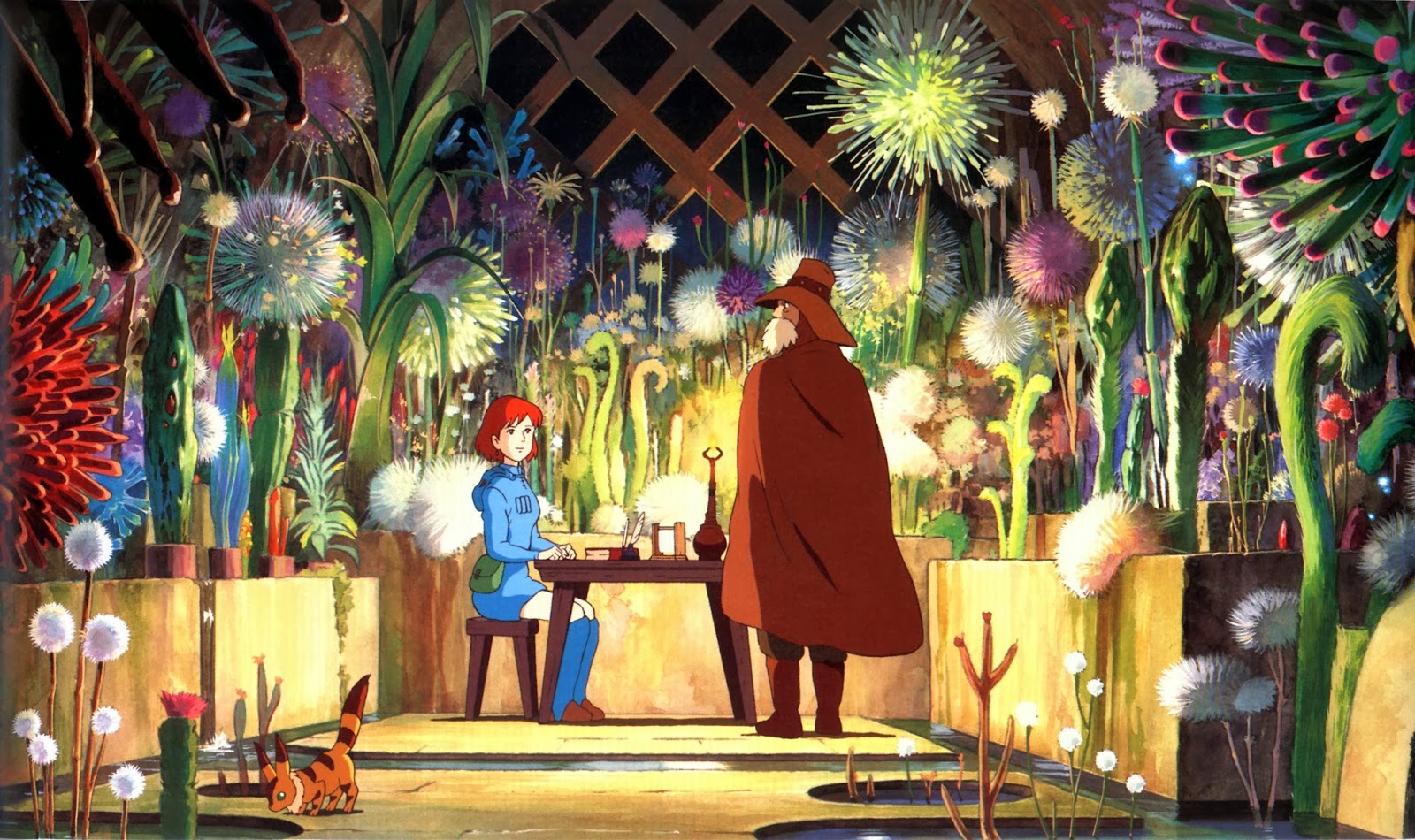 An aircraft from the kingdom of Tolmekia crashes in the
Valley of the Wind. The lone survivor is Princess Lastelle of the kingdom of
Pejite. Nausicaa is unable to save the princess but, before she succumbs to her
injuries, she urges that the ship’s cargo be destroyed. Tolmekian troops, led
by Princess Kushana (Yoshiko Sakakibara), arrive in the Valley to take the
cargo, the embryo of a legendary Giant Warrior. They kill Nausicaa’s father,
seize the embryo, and take hostages to ensure the population’s compliance.
Nausicaa is one of those hostages. She is placed on a transport headed for the
Tolmekian capitol but, along the way, the ship is attacked by a Pejite fighter.
Initially, the liberated Nausicaa believes she has found new allies but she
soon discovers that the Pejites are as inflexible as the Tolmekians in their
intentions. A clash between the two sides seems inevitable with the Valley in
the Wind as the battleground.
An aircraft from the kingdom of Tolmekia crashes in the
Valley of the Wind. The lone survivor is Princess Lastelle of the kingdom of
Pejite. Nausicaa is unable to save the princess but, before she succumbs to her
injuries, she urges that the ship’s cargo be destroyed. Tolmekian troops, led
by Princess Kushana (Yoshiko Sakakibara), arrive in the Valley to take the
cargo, the embryo of a legendary Giant Warrior. They kill Nausicaa’s father,
seize the embryo, and take hostages to ensure the population’s compliance.
Nausicaa is one of those hostages. She is placed on a transport headed for the
Tolmekian capitol but, along the way, the ship is attacked by a Pejite fighter.
Initially, the liberated Nausicaa believes she has found new allies but she
soon discovers that the Pejites are as inflexible as the Tolmekians in their
intentions. A clash between the two sides seems inevitable with the Valley in
the Wind as the battleground.
The film’s underlying thesis relates to the need to preserve
the natural order of things and any attempts to “improve” the world can have
unintended, catastrophic impacts. The Toxic Jungle is perceived by most populations
as being dangerous and undesirable. Nausicaa learns, however, that it’s a vital
element of the planet’s eco-system and “burning it away” (as the Tolmekians
intend) won’t give human beings an unblemished world but could result in an
extinction-level event.
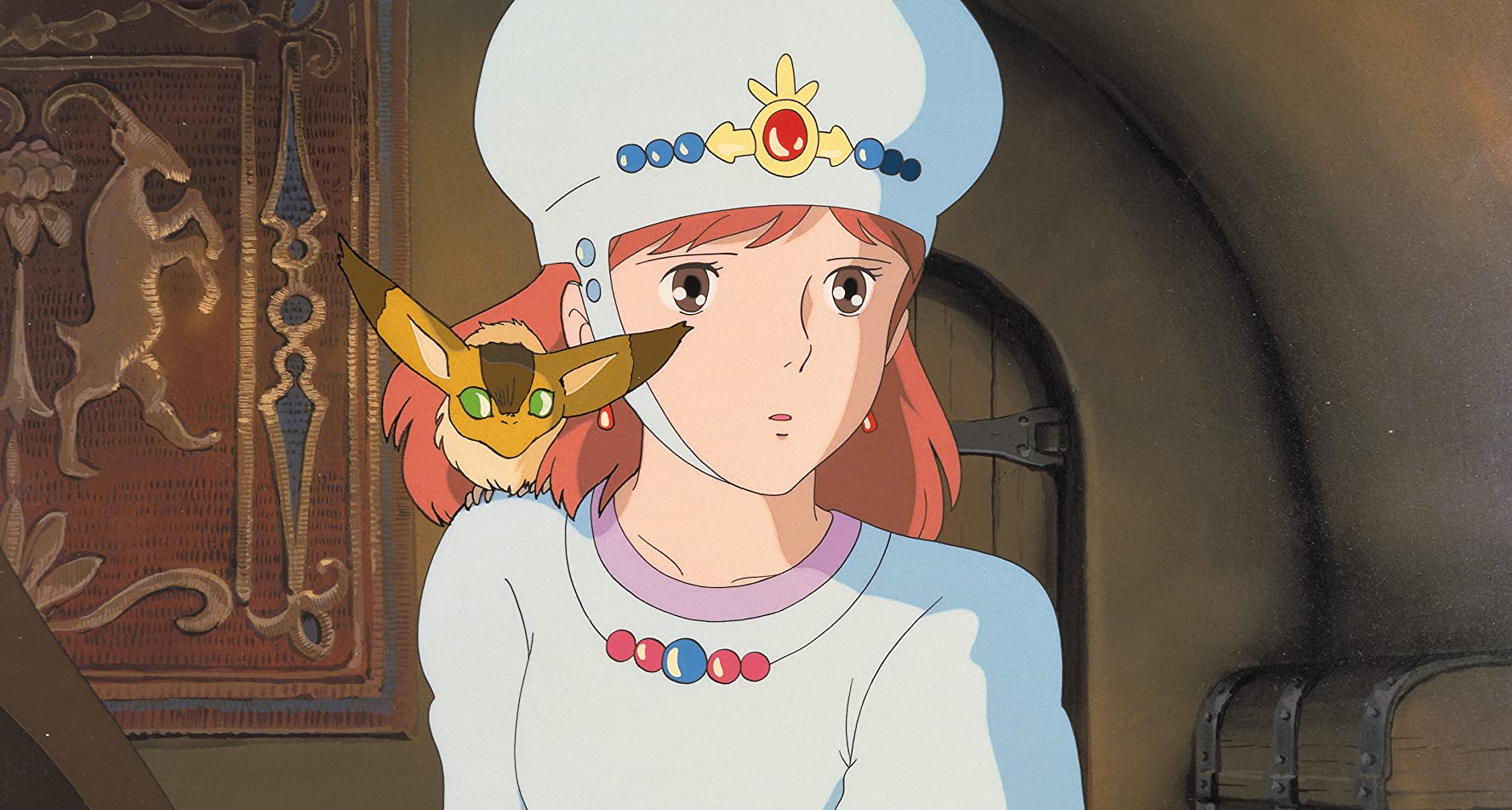 It’s hard to become involved in the plights of the various
factions since the political dynamics are developed in such a haphazard manner.
This aspect of the film would have benefitted from a longer running length and
more exposition. Some of the secondary characters are underdeveloped. Lord Yupa
(Goro Naya), a feared swordsman of great renown, seems destined to play a
bigger part than he does. A friendship between Nausicaa and Princess Lastelle’s
brother, Asbel (Yoji Matsuda), is pushed into the background after a promising
beginning. From beginning to end, there are indications that sacrifices were
made to streamline the manga and not all of those worked.
It’s hard to become involved in the plights of the various
factions since the political dynamics are developed in such a haphazard manner.
This aspect of the film would have benefitted from a longer running length and
more exposition. Some of the secondary characters are underdeveloped. Lord Yupa
(Goro Naya), a feared swordsman of great renown, seems destined to play a
bigger part than he does. A friendship between Nausicaa and Princess Lastelle’s
brother, Asbel (Yoji Matsuda), is pushed into the background after a promising
beginning. From beginning to end, there are indications that sacrifices were
made to streamline the manga and not all of those worked.
The Japanese version of Nausicca was released in
March 1984. A year later, a dubbed and truncated edit, called Warriors of
the Wind, began a staggered release to English-speaking markets (including
the United States, where it debuted in late 1987). Warriors of the Wind,
which clocked in at a skinny 95 minutes, was largely incoherent. Considering
the complexity of the full cut, it’s hard to believe that anyone thought a shorter
edition could be better. The film wasn’t successful financially outside of
Japan and Miyazaki was reportedly horrified by the changes. This impacted his
dealings with American importers for many years. One of his stipulations when
he signed the deal with Disney was that there would be no cuts.
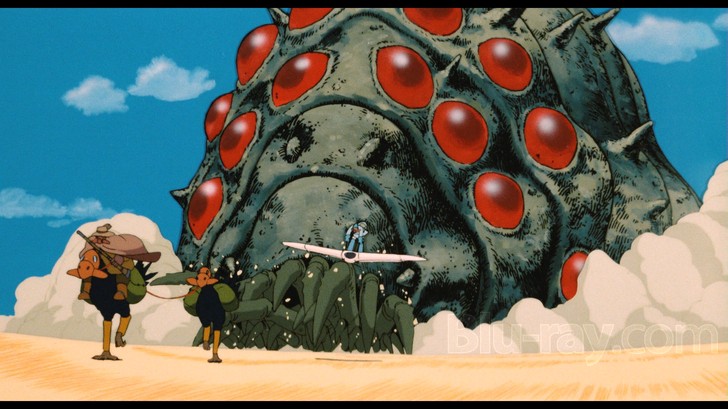 In 2005, Disney released a new version of Nausicaa to
the North American market. In keeping with Miyazaki’s demand, it was unedited.
The dubbed soundtrack was all-new and featured the vocal talents of Patrick
Stewart (as Lord Yupa), Shia LaBeouf (as Asbel), Uma Thurman (as Kushana), and
Alison Lohman (as Nausicaa). As with many of the Disney dubs, the changes to
the dialogue occasionally resulted in subtle changes to the perception of
certain scenes. Eriko Ogihara-Schuck has argued that the 2005 English-language
version “Christianized” certain thematic and textual aspects.
In 2005, Disney released a new version of Nausicaa to
the North American market. In keeping with Miyazaki’s demand, it was unedited.
The dubbed soundtrack was all-new and featured the vocal talents of Patrick
Stewart (as Lord Yupa), Shia LaBeouf (as Asbel), Uma Thurman (as Kushana), and
Alison Lohman (as Nausicaa). As with many of the Disney dubs, the changes to
the dialogue occasionally resulted in subtle changes to the perception of
certain scenes. Eriko Ogihara-Schuck has argued that the 2005 English-language
version “Christianized” certain thematic and textual aspects.
As I have indicated for all of the Miyazaki films, the best
way to watch them is via one of the newly subtitled versions available through
GKIDS (there were issues with the Disney subtitles). However, for younger
children who may not yet be able to read or who may be uncomfortable doing so,
the dubbed version is an acceptable substitute.
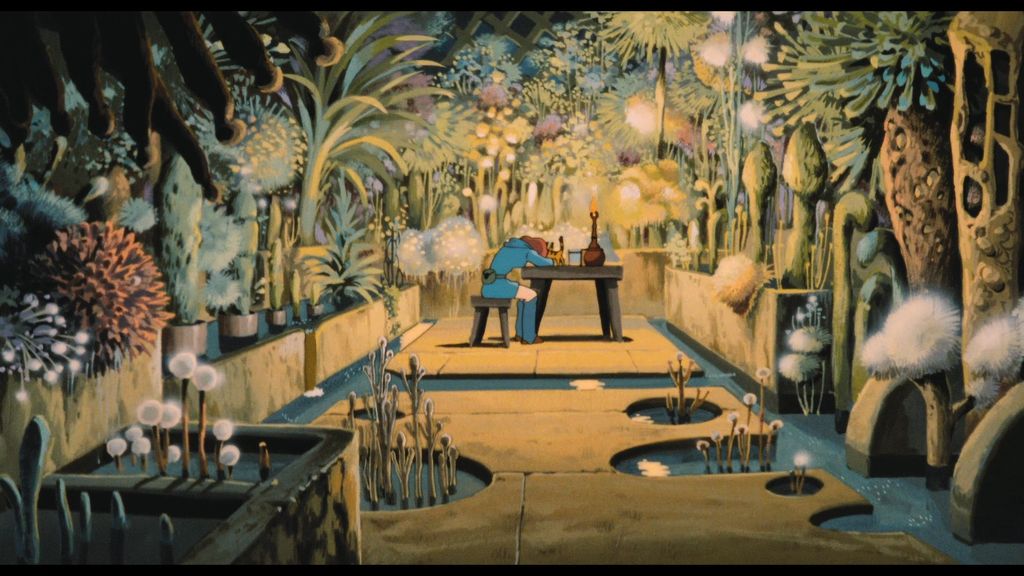 Another tidbit worth mentioning about some of the earlier
versions of Nausicaa is that, due to improper color correction, there
appear to be several occasions in which Miyazaki provides viewers with an
“upskirt.” In actuality, Nausicaa is wearing tight-fitting white pants under
her skirt; these appeared to be flesh-colored in some of the releases. This has
been corrected with the GKIDS Blu-Rays. Those who might have been shocked by
this can rest assured that Nausicaa is not flashing the audience.
Another tidbit worth mentioning about some of the earlier
versions of Nausicaa is that, due to improper color correction, there
appear to be several occasions in which Miyazaki provides viewers with an
“upskirt.” In actuality, Nausicaa is wearing tight-fitting white pants under
her skirt; these appeared to be flesh-colored in some of the releases. This has
been corrected with the GKIDS Blu-Rays. Those who might have been shocked by
this can rest assured that Nausicaa is not flashing the audience.
Nausicaa of the Valley of the Wind is most fascinating when seen as a prototype for future Miyazaki films. Clear connections are evident between this movie and both Castle in the Sky and Princess Mononoke. And, although the narrative at times becomes jumbled, many of the individual scenes stand out as outstanding action/adventure pieces with innovative visuals and a breakneck pace. The movie never pauses or slows down. It’s far from the strongest entry into Miyazaki’s canon but is at least as good (if not better) than most of the current Hollywood-engineered animated fare and, despite having been produced more than 35 years ago, it doesn’t show its age.
Nausicaa of the Valley of the Wind (Japan, 1984)
Cast: Sumi Shimamoto, Goro Naya, Asbel, Yoshiko Sakakibara, Iemasa Kayumi, Ichiro Nagai, Hisako Kyoda
Home Release Date: 2020-07-12
Screenplay: Hayao Miyazaki, based on his manga
Cinematography:
Music: Joe Hisaishi
U.S. Distributor: GKids
U.S. Release Date: 1987-11-25
MPAA Rating: "PG"
Genre: Animated/Fantasy
Subtitles: In Japanese with English subtitles (or dubbed)
Theatrical Aspect Ratio: 1.85:1
- My Neighbor Totoro (1993)
- (There are no more better movies of Sumi Shimamoto)
- (There are no more worst movies of Sumi Shimamoto)
- (There are no more better movies of Goro Naya)
- (There are no more worst movies of Goro Naya)
- (There are no more better movies of Asbel)
- (There are no more worst movies of Asbel)

Comments